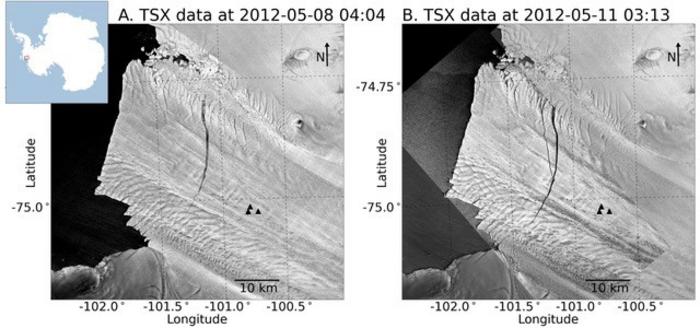Scientists believe they have evidence of the fastest-moving crack in an ice sheet ever recorded. The 10.5-kilometer (6.5-mile) crack formed through an Antarctic ice sheet at a blistering speed of 35 meters (115 feet) per second, or about 128.7 kilometers per hour (80 miles per hour).
Researchers at the University of Washington observed the lightning-fast crack emerge in 2012 at the Pine Island Glacier Ice Shelf, the fastest melting glacier in Antarctica, which accounts for around 25 percent of Antarctica’s ice loss.
They made the observations using data from instruments placed on the ice shelf by other researchers and radar observations from satellites.
“This is to our knowledge the fastest rift-opening event that’s ever been observed,” lead study author Stephanie Olinger, who carried out the study as part of her doctoral research at the University of Washington and Harvard University and is now a postdoctoral researcher at Stanford University, said in a statement.

Satellite images taken May 8 (left) and May 11 (right), three days apart in 2012, show a new crack that forms a “Y” branching off to the left of the previous rift.
Image credit: Olinger et al./AGU Advances
A rift is a crack that passes right through an ice shelf. They are often the precursor to shelf calving when large chunks of ice break off a glacier and fall into the sea.
Other rifts in Antarctica can form over months or years. However, as this study shows, they can also occur in mere moments, especially in the most vulnerable parts of Antarctica.
“This shows that under certain circumstances, an ice shelf can shatter. It tells us we need to look out for this type of behavior in the future, and it informs how we might go about describing these fractures in large-scale ice sheet models,” explained Olinger.
Scientists are keen to understand the physics of how glaciers break apart, not least because climate change is set to thaw Antarctic ice sheets and increase the frequency of rift-opening events.
Glacier ice appears to act like a solid on short timescales, but it behaves like an oozing honey-like liquid on longer timescales. While this new study does suggest that ice can shatter like broken glass, the researchers believe the crack would have formed even faster if ice behaved like a simple, brittle material.
“Is rift formation more like glass breaking or like Silly Putty being pulled apart? That was the question. Our calculations for this event show that it’s a lot more like glass breaking,” Olinger said
“Before we can improve the performance of large-scale ice sheet models and projections of future sea-level rise, we have to have a good, physics-based understanding of the many different processes that influence ice shelf stability,” she added.
The new study is published in the journal AGU Advances.
Source Link: Antarctic Glacier Cracks At Record-Breaking 80 Miles Per Hour